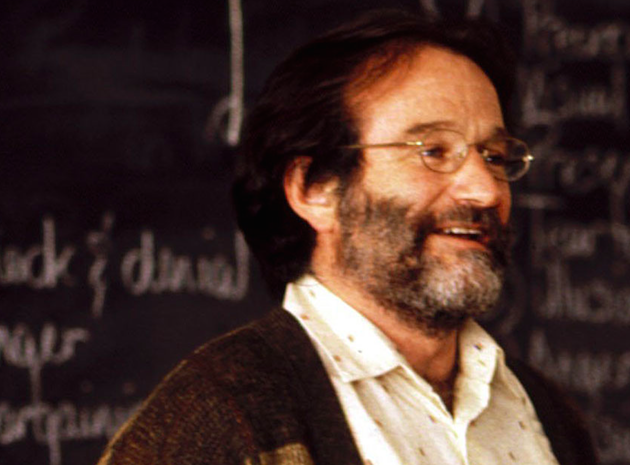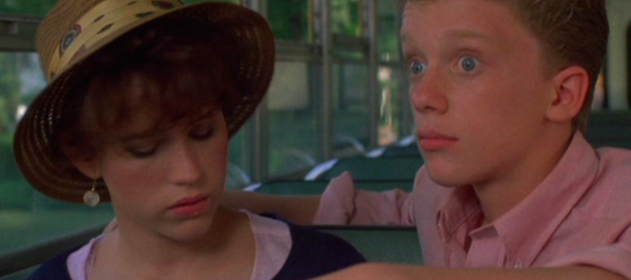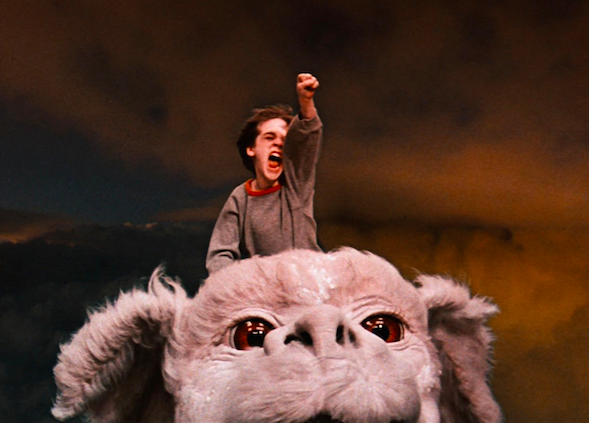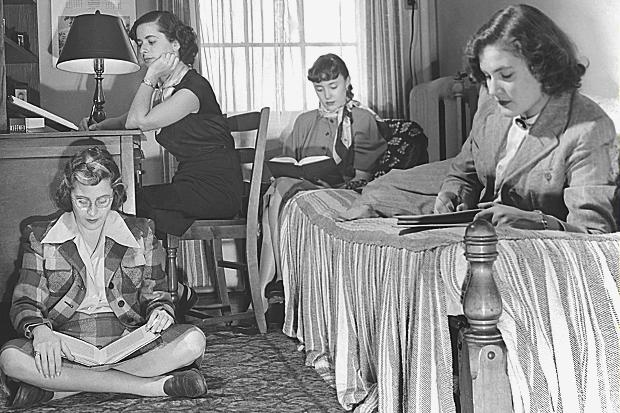A Sixteen That’s Not So Sweet ● by Michael G. Glab
Julia Karr had a vision of the world in the year 2150. In this vision, she saw teenaged girls buffeted from all sides with messages that they should be sexy. If they’re not, well, they’re beyond help. In fact, in Karr’s fantasy world girls who hit the age of 16 are celebrated because they are now legal; that is, they can have sex, fulfilling all expectations — really, the only expectation.
Karr titled her first book XVI. The numeral is Roman, indicating what a momentous landmark it is to reach that age, as important as our world’s Super Bowl. In it, she lays out her dystopia in detail. XVI and its sequel Truth are Young Adult novels in the speculative fiction genre. Their main character is Nina, a rebel who is certain there must be something more for her than simply becoming a sex toy.
YA books with female characters generally are gobbled up by teenaged girls. But Karr has found the boys seem to like Nina and her story just as much as the girls do.
“They do,” Karr says. “I did a Library Talk up in Indianapolis. A teacher had brought in her senior English class. XVI was required reading for the class. Half of the students that came were guys. It was an underprivileged school. The thing that was wonderful was everybody had read the book. Most of the questions I got were from the guys. There was one guy who said ‘You know I never even bothered to read a book before we had to read this and I just couldn’t put it down. Afterward, I had one kid come up to me. There is a scene in the book where the police come and tear through Nina’s apartment, looking for stuff. This kid comes up to me , and he’s like towering over me, and he says, ‘That police scene, they really do that. How did you know that?’
“First thing I thought was, ‘Well, he knows they really do that, too.’ I said, ‘You know, I’ve been in that situation before. I’ve had them come and go through my house like that. So I understand it.’”
Thus proving one of Karr’s core beliefs: The writer is always writing. “You are even if you don’t think you are,” she says. “While you’re doing other things, your mind is constantly processing.” Even when Karr is pulling weeds in her garden, she’s thinking about her feelings, her situation, and filing those thoughts away in case she needs to use them in some as yet unwritten chapter. To write the scene in which the cops ransack Nina’s home, she reached back to the night when she (Karr) was 20 and the police were tearing through her apartment. The circumstances were funny, but the feelings she had that night came in handy nearly 40 years later when she was an author.
“It had to do with a spider,” Karr says. “A giant spider. I came home, there was a giant spider in my house. It was two o’clock in the morning. What do you do? I saw it and then it ran. It was just a small apartment, a studio apartment. I called my brother in law and I said ‘Come over there’s a spider…!’ He said, ‘It’s two o’clock in the morning — call the cops,’ and hung up on me. So that’s exactly what I did; I called the police and I said, ‘I don’t know if it’s somebody’s pet tarantula or what….’ We’re talking a giant spider. The police show up and, obviously, what do they think? We’re talking 1970 or so — she’s on LSD!
“They tore my apartment apart. They looked through the drawers. They looked through everything. And they didn’t find the spider. Meanwhile, I’m perched on my bed, watching the door. I did not see the spider go out the door so I knew the spider was still in when they left.”
Some friendly neighbors came by to console her after the police had rousted her apartment. One of the neighbors eventually found and killed the spider. “That thing curled up into something the size of a jacks ball,” Karr recalls.
“So, I was able to use that — How you feel when the police are there? You feel powerless. They’re going to do what they’re going to do. I was able to put that in my story. What happened to me back then resonated with a seventeen year old black kid from a disadvantaged part of Indianapolis. So, you can connect with your readers if you’re honest about what you’re writing. It all comes down to honesty, and he connected with that. All that goes to say, guys read my books, the girls read ‘em, and they all have something to say.”
●
Julia Karr: Every writer writes differently. But when I’m just sitting there staring off in space and there’s a blank computer screen in front of me, what I’m usually doing is seeing what happens next. Case in point: I’ve been revising my recent work in progress. Here I am, writing this new beginning, a new opening for my story, and lo and behold, first paragraph, a new character appears! He’s definitely a foil for my main character. I’m like, ‘Whoa!’
I’m not giving anything away when I say there’s fencing in this scene. We’re talking the grand art of fencing which I know very little about other than the fact that Inigo Montoya and the Dread Pirate Roberts — in the greatest scene in the world — the two of them are fencing at the top of the cliffs in The Princess Bride. So, somehow or another, fencing seemed to work into my story and I didn’t know anything about it. I went to the library and got a couple of books out about fencing. If I were maybe 30 years younger, I might consider learning how to fence — and I might anyway! Who knows? But I’m reading these books and I’m learning and I’m thinking about it and I’m understanding some things about the rules of fencing and how opponents interact with each other. It hit me that at the end of a fencing match, you salute your opponent. You have your sword out to the side and you bring your hand up toward your chin in a salute. You’re not supposed to look triumphant. You’re not supposed to look downtrodden. Won, lost, whatever; you’re supposed to have a very even demeanor. I thought about that. I was visualizing. My main character has just finished with this bout and she’s going to salute this person.
Who is this person? Is it just some nameless opponent? Or is there some kind of history going on there? All of a sudden this character just popped up and said ‘This is who I am.’
Michael G. Glab: So, the book writes itself?
JK: It does. I think it was Handel who said, ‘I’m taking dictation from God.’ I have struggled putting words down on the page, more often than not, but I have also found myself in the zone where it’s more like I’m reading what’s on the page rather than typing. Your subconscious is an amazing thing and it definitely takes over. I’ve discovered this not only from this zonal writing which is wonderful and doesn’t happen nearly as often as writers would like it to, there’s also this strange coincidence that happens, this little bit of serendipity, where you write something in your early chapters and you’re not exactly sure why you wrote it and then you end up, as you’re writing the end of the book, and all of a sudden you realize how important that one little thing that you put in chapter two suddenly becomes. If you hadn’t put it in there, you wouldn’t have gotten to this point but you didn’t even realize it when you wrote it. That happens a lot. In some of the books I’ve read about writing, people talk about that. They say, ‘If something feels like it needs to be included, include it, because you can always cut it later. But you never know if it is going to be the hinge for your plot.
It’s kind of like the seventh Harry Potter book. J.K. Rowling was explaining and bringing to fruition and closing doors and opening windows of things that happened in the first six books, that you had almost even forgotten about. She knew she was writing seven books.
MG: She wrote in coffeehouses. Describe your writing space.
JK: I usually write at my dining room table. It’s just a circular table, I plug in my laptop, sit down, fight off the cats who feel like they have to lay on the keyboard. I’ve got my cup of tea. I like to get up early before the rest of the world is up, do a little bit of journaling, and then get into whatever I’m working on. So it’s dark out, the shades are drawn.
The thing is, the minute I see the sun, I want to be doing something outside. I want to be physically doing something rather than writing.
MG: Nina, your protagonist in XVI and Truth, turns 16 in the year 2150. What is significant about 16?
JK: In the book, girls become adults at 16. They are basically primed, by the media — and if any if this sounds familiar, I’m not surprised — by shows, by radio, by advertisement, whatever the means are at that point in time, a constant media bombardment — to be sexual. That they are sexual beings before they become people. The most important thing for a girl is to be attractive to the opposite sex.
MG: It does sound familiar because a lot of that goes on now.
JK: Exactly. That was one of the things that really hit me: If our society continues on unchecked — and, believe me, I’m not a prude; people are sexual beings — but girls at eight do not need to have push-up bras. Little babies don’t need to have….
MG: Underpants that say ‘Juicy’? I saw an ad for them the other day.
JK: Right. People don’t need to be sexualized. We are sexual. It doesn’t need to be the focus of who you are. Nina’s best friend, Sandy, in XVI, has totally embraced the 16-idea. Sixteen Ways is her favorite zine. She buys into all of their how-tos. She wants all the guys to want her. And the price for that is that she has no life. Nothing means anything to her except that.
MG: But at the age of 16 you’re so desperate for an identity.
JK: You are. And if you’re being bombarded by the media that tells you that your worth is tied up in your sexuality…. And that’s the thing about XVI: It’s not just the girls who are taking this in. It’s the guys. They are taught to see girls as sexual beings, not as people. The resistance, the underground in the book, are people that want to see the whole person, but even there, there are problems. And that goes into the second book, Truth, where these guys still are having a hard time because they are bombarded with the same messages that the girls are. You’re still looking at that girl as somebody who’s a sexual being or needs to be protected from rape, from being exploited. That’s a thing our society is currently grappling with. Teens are like the opening flower, if you will. What is it that you’re fertilizing them with? It’s ingrained in our society already. Honestly, when I was writing this, I was kind of despairing. We’re so close already.
MG: XVI came out in 2011 and Truth in 2012. As I was checking all the comments from your loyal readers on various book sites, they were saying, ‘There’s got to be more!’ It’s clear to everybody. Well?
JK: I know that Nina hasn’t left my brain because she keeps showing up saying, ‘Well, what if you did this? What if I went here?’ So, I have been fleshing out some ideas for a third book. It may be more of a companion book than a sequel. A couple of years will lapse.
MG: A website called Parental Book Reviews, which ranks books for teens, has these categories: Sexual Dialogue — you’re ranked Heavy. Sexual Content — Moderate, with mentions of rape. Profanity — Heavy….
JK: That’s puzzling because, you know, slang changes. I had different words for sex rather than….
MG: Maybe they were projecting: ‘Oh that’s going to be a dirty word in 150 years.’
JK: And it certainly was going to be a dirty word 150 years in the future.
MG: Violence — Moderate to Heavy.
JK: Yes.
MG: And here’s a catch-all, Other Notable Ideas — the site writes that guys have a say in girls’ pregnancies, whether or not they can have an abortion, etc. I don’t know if that’s a problem in the site’s view or what. Have you had any problems with censorship or banning?
JK: Not that I’m aware of.
MG: High schools are assigning your books.
JK: Yes. Some of my biggest fans are teachers and librarians. People that love it, love it. And people that hate it, hate it. All you have to do is go to Amazon and the first review is one star and that person willfully chose to misunderstand everything that I was talking about.
MG: You put your stuff out there, you take your chances.
JK: And it’s not yours anymore. You write it for yourself, but when you send it out there, it’s like sending your kid to kindergarten — you can’t make everybody in the classroom like him. And you can’t stand over the other kids in the classroom and say, ‘You, What do you mean you don’t like my kid?’ Same way with the books.
MG: When I write, there’s always someone I’m writing to. Do you do that?
JK: No.
MG: It’s not the same person all the time. It’s different people. I pick a face of someone I know and esteem and say ‘I’m telling you this story.’
JK: Oh, cool. That’s very cool. I don’t do that.
Nina’s story? I’ll tell you how she showed up. One day, into my head just popped a picture of a punk rock girl. Spiky hair. Different colors. Miniskirt. Lots of bracelets with studs on ‘em. Heavy eye makeup. Boots. She’s walking down a city street and she trips over a homeless man and just keeps on walking. She’s got her earbuds in, you know? And then she stops and she turns around and she looks at him and she thinks, ‘I have to do something for him. I have to acknowledge him. I cannot just leave him there any more.’ That was just like this little picture that popped into my head for five seconds.
MG: A personality came out of that vision.
JK: Right. Here’s this person.
That year I decided to do National Novel Writing Month, which is November. You get 30 days to write 50,000 words. One of their catch phrases is No Plot? No Problem. All you need is a main character and a location. I had a main character and I had a location — but it was New York City and I don’t know New York City. I’ve only been there once. I did live in Chicago for five years and I loved it. I turned 16 in Chicago.
MG: You were a high school kid.
JK: Well, I was a high school kid until I dropped out at the end of my sophomore year.
MG: A dropout!
JK: I’m a dropout. Went back and got my GED and I’ve done some college but I made my way with a part of a high school education.
I knew Chicago so I took my character Nina, my little punk rock girl, I sat down and I said, ‘Girl, you’re going to have to tell me your story because I don’t know what it is.’
I started writing. I knew a little bit about who she was; that she was somebody who was no longer comfortable with the status quo.
During the Lotus Festival, you have a wristband on. You walk up and you hold up your hand so that the ushers will see that you have a wristband and you can go in. You don’t have to say a word. So when I started writing this it was the first of November; Lotus had been over for, what, a month? That kind of worked its way into the story. Identification on the wrist – the story evolved from there. I wrote it in 30 days. I had my basic story. And I let it sit for a while and I went back and revised, and revised, and revised. That was 2009. It was just a dream. When I wrote it I said, ‘Wow, this is pretty good.’
[
At the time, Karr was part of a critique group and had been working on another, unrelated book. She eventually scrapped the other book because it needed too many revisions.]
JK: So, in order to have something to show to my critique partners, I brought them XVI. And they loved it. They were like, ‘This is your book. Start tweaking and tightening it up and making it a book.’ Which I did.
MG: When your critique partners said, for instance, ‘You know, I don’t like this or that,’ how long did it take you not to want to strangle them?
JK: I’m pretty open to just listening and trying to understand from somebody’s else’s point of view.
MG: You don’t take criticism personally?
JK: The gals that I was working with on XVI, we would sit and talk it over: ‘Well, you know. I really don’t get this part,’ or, ‘This doesn’t sound right,’ or, ‘Would she really say that?’ or, ‘This doesn’t make any sense.’ When choosing critique partners you have to choose people that you know want you to be better. They’re not your relatives, heaven forbid. Your relatives will read anything and say, ‘Oh my god, this is wonderful!’
I just recently joined a critique group that has some awesome authors in it, some published, some not published. They are hard. Which is good. They’re not lying to me. They want my work to shine and they know it’s not going to shine unless I hear the hard truth about what’s wrong with it. They’re not trying to rewrite it; they’re just saying, ‘This doesn’t work. I stopped reading here. Why are you doing this?’ They’re excellent. I absolutely love them. I don’t get emotional about critiques because I recognize I’m trying to get better. What do they say? If you think you’re a master, you’re not. I don’t think I’m a master. I just want to get better.
MG: What did you read when you were 16?
JK: Oh my! I was reading fantasy, I was really into science fiction for a while. Robert Heinlein and Frank Herbert. I also was reading Michener. I was reading Ayn Rand. I started reading when I was three. I have an older sister and she could read and I wanted to read. So she taught me how to read. She would read to me and I would figure it out.
I even got my picture on the front page of the Seymour Daily Tribune when I was six years old because I was the youngest kid to go through the summer reading club. Yes. I hadn’t even started first grade yet. I always read. The Seymour Public Library was great. I went through the children’s room by the time I was 12. I had everything in there read. Then I moved on to westerns and mysteries. There really wasn’t a lot of Young Adult fiction back then. I can remember when I was in seventh or eighth grade, I wanted to check out Gone with the Wind. The librarian called my grandmother — I grew up with my grandmother — to make sure it was alright to check the book out to me.
Right now I’m reading all the Inspector Linley mysteries by Elizabeth George. I also am on a kick: I have decided to read biographies of all the presidents of the United States, including Benjamin Harrison, if there’s something for the 21 days that he was in office.
The Ryder ● September 2014












